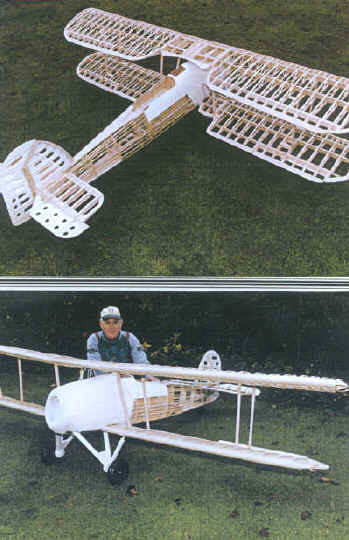The Fairey Swordfish, the legendary ‘Stringbag’, was a Torpedo Spotter Reconnaissance biplane dive-bomber which went into service with the Fleet Air Arm pre-war in 1936. Initially, Swordfishes operated from the large fleet carriers. Later Swordfishes operated from escort carriers, and were very effective against U-boats. The Swordfish remained operational until the end of World War II, gaining the distinction of being the last biplane to see active service.
It was September 1998 when down at the local flying club Roger was deep in conversation with some friends about what to build this winter. He was kidded that he manages to ‘knock up a model every season’, but Roger claims it is not really true. The topic of a Swordfish was muted, but Roger though it was a bit of a tall order for him. The thought stuck though and whilst flying at the Three Counties event Fred Jackson offered to loan Roger an old RC Model World CAP plan for a 61.5″ wingspan model designed by W. H. Taylor.
Off went Roger to get it enlarged and hey presto he now had the outline for a 10ft 1 inch version. Having spent a fortune on the enlargements he though he had better build the model. Of course, modifications were necessary to the original drawings such as extra ribs and resizing of the wood. The fuselage also needed to be split rear of the crew gun position in order to get it into his caravan.
The main front of the fuselage was made into a box structure to take a 75cc engine.
Roy Salter helped out with some initial photographs taken at RAF Swanton Morley a few years earlier. A fellow pilot, John Norman gave Roger a gift of a book, Swordfish Special by W. A. Harrison.

Building began in October 1998 and most of the structure was completed by Christmas. The wing ribs were all built using a jig, four at a time. There are 34 ribs on the top wing and 28 on the lower one (which is smaller and required a different jig).
The undercarriage was made form 1/4″ piano wire plus springing on the oleo legs as per the full-size. The wheels were 7″ balloon type.
For the tailplane Roger experimented using foam board for the elevators and rudder. This proved to be a strong and quick construction technique.
The tailwheel is attached to a servo for ground steering with a removable servo tray in the front of the rear section of the fuselage. The servos for the elevators and rudder are via a slave linkage for easy removal of the servos if required. Flying wires and fork ends were bought from Mick Reeves and silver soldered. Thirty six of these were completed.
Switches for the magneto, 6V and 4.8V systems went into the pilots area and an opto-system from SM Services with on-board battery checker was wired-up.
To check on some scale details Roger was allowed to view the three Swordfishes at the RAF Historic Flight, Yeovilton. He left armed with more information, coloured booklets and photocopies of details.
The finished airframe was covered in 20m of white Solatex. Roger’s wife, Jenifer, was advised that as a Christmas present a financial contribution towards a super-de-lux spray compressor and airbrush would be appreciated. As Roger says, all the lads have them now don’t they.
The 25% scale aircrew were bought from AH designs. They are full -length in uniform and with Mae Wests.
The Lewis/Vickers gun was a challenge. There is not a commercial one available at 1/4 scale so with the aid of a photocopier and a mini datafile booklet one was created. This was fitted onto the scarf ring insider the rear compartment, which was painted black and had seats for the crew.
The retracting flag is another nice feature of the model.

Roger said the engine was a beautiful thing, with its own silencer which of-course would not fit into the space allowed for it. More ingenuity and brazing were needed and some carving of the cowl, but he got there in the end.
Balancing is not a simple task on a large model. Roger’s flash of inspiration was to use a pulley system. Off to the local ironmongers he went for two pulleys and nylon rope which was installed on the workshop roof beam. He also used the system to weigh the model by using the system as a large set of scales. Final weight was 33lbs without fuel.
The full-size ones at Yeovilton are mock-ups made of fibreglass and double as storage space for tools. Roger tried a cardboard roll from a carpet he found in a skip – no good. He then tried to use a drainpipe – no good. Eventually one was made from 3″ discs of foam board with a 3″ tube of glossy card with a blas nose block and a one foot long paper tapered end with fins. The body was painted black and the nose red. It is cliped to the underside of the body with scale brackets. It is a good feature on the model.
Like a bird claims Roger. On the 16th March three gloriopus flights were made and Roger says he has never had a plane as good tempered or which flew as well. At the Withernsea fly-in over the May bank holiday it had another 14 flights. Since then it has been a joy to fly and has been taken to many shows and LMA events.

For event tickets, merchandise and more visit our online shop.